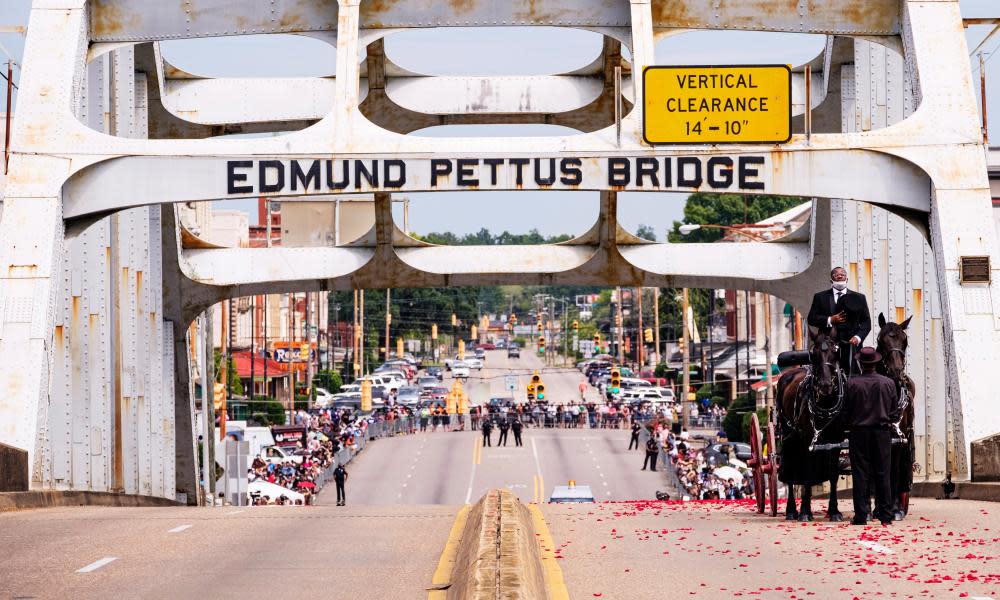John Lewis and other activists made history on Selma's bridge. Why is it still named after a white supremacist?

This past Sunday, I was privileged to attend the final crossing of the late congressman John Lewis over the Edmund Pettus Bridge in my hometown of Selma, Alabama. Watching him cross the exact bridge where he was beaten decades ago while marching for civil rights was an emotional and full circle moment.
Thinking about John Lewis and his works made me think about how we live in a world driven by trending topics. Every hour of every day is controlled by a new conversation started by either a viral tweet, a lone interview or an online video, such as those of protesters felling Confederate statues this year amid an uprising against police brutality. However, the debate over whether or not to rename the Edmund Pettus Bridge, named after a Confederate general and Grand Dragon of the Ku Klux Klan, in Selma, is decades in the making, as is the fight for civil rights. And it’s not as simple as it may seem.
Related: In Selma, 55 years after Bloody Sunday, concern rises over voting rights
Selma has always been considered the beating heart of the voting rights movement, because of the historic march to Montgomery. During the first attempt on 7 March 1965, marchers led by Lewis, the late Dr Frederick D Reese, the late Hosea Williams and others were met on the other side of that bridge by state troopers on horses, and billy clubs. In the aftermath, the nation watched in horror as the troopers forcibly drove the marchers back to Brown Chapel AME church, leaving a trail of blood and injury in its wake.
That day, which we recognize as “Bloody Sunday”, forever changed and shaped how the Edmund Pettus Bridge is viewed. So it is no surprise that there is opposition to the growing calls to change its name. For many of my neighbors, the Edmund Pettus Bridge is not and will never be a symbol of Edmund Pettus himself, but of the events that transpired there. Many Selma natives, including Congresswoman Terri Sewell, take pride in the fact that a bridge intended to honor a Confederate general and Grand Dragon of the Ku Klux Klan will forever be known as a representation of voting equity, civil justice and hope. It is an irony that can work in our favor, and a symbol of victory over evil.
Additionally, many of our foot soldiers, those who participated in the original marches, and surviving members of the movement feel as if they have been forgotten in this debate. Over the years, we have seen sitting presidents and other leaders come to Selma once a year to commemorate the Bloody Sunday march, while making commitments to work with Selma to ensure its legacy is preserved and protected. However, many of these commitments never see the light of day, and those who fought for the country’s voting rights are left behind and out of the debate altogether.
There have been numerous petitions and calls made by notable people such as Ava DuVernay and Tyrese Gibson for years to bring Pettus’s name down. And with recent events there is more pressure on Selma than ever to take down statues of Confederate generals and even state flags with Confederate symbols. Even Sewell changed her stance, saying that this moment – spurred by recent protests – meant challenging some of those beliefs. But I believe that should we change the name now, it should not be because of the national push, but because of a genuine attempt to honor John Lewis, who was born just 86 miles away.
I am a true proponent of honoring heroes in the proper manner. When it comes to renaming the bridge in his honor, I believe you cannot necessarily limit just one honor to the works that John Lewis has done for the advancement for not just Black Americans, but for every American. Renaming the bridge, then, would not only honor Lewis but serve as a model for how we educate students about the civil rights movement. Our schools now only teach bits and pieces of a story that should be rendered in its entirety.
Should we change the name now, it should not be because of the national push, but because of a genuine attempt to honor congressman Lewis
But it’s important that the deciding factor ultimately be left to the local community here in Selma. There are economic, political and legal impacts that affect Selma’s citizens that will not affect others who do not live here if we rename the bridge. With the changing of the name, what will that look like for Selma? Is there an economic plan in place to ensure that Selma will thrive even after we are no longer the trending topic? Are we properly prepared for the legislative battle that will be in store with this process? It is absolutely crucial that the opinions of our people are not forgotten and there is work actively being done to ensure that will happen.
I have had the privilege to travel to numerous places, and I can confidently say that there is no place like Selma. My home town changed the world and I believe we are still more than capable of doing it again. The truth is that Selma was organizing before 1965 and continued to organize after. This past weekend has inspired me, as I hope it has inspired everyone to get into some of what Lewis called “good trouble”, and the people of Selma should determine what that means for our bridge.
Collins Pettaway, III is a native of Selma, Alabama. He is a communications specialist, freelance writer, founder of his consulting group, The Pettapull Firm, LLC, and local radio personality. He has worked with local and state government agencies regarding community advancement and civic engagement

